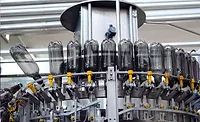Distilleries, craft brewers see benefits of HVLS fan installation
High-volume, low-speed ceiling fans can regulate temperature, humidity

Temperature and humidity conditions have profound effects on beverages such as beer, bourbon and wine; yet, maintaining ideal conditions in large production facilities, distribution centers and cellars can be costly. Craft breweries face particularly unique challenges, as they often occupy non-traditional spaces with outdated doors and windows, and little insulation.
The following are some ways in which large, overhead fans can improve processes throughout the beverage industry, often at a fraction of the cost of HVAC introduction and facility sealing and insulation.
The primary use for fans in distilleries is to create a consistent temperature profile from floor to celing to ensure the controlled aging of spirits, as distillery rack houses heat quickly.
In the largest rack houses, air at the ceiling can be 20 degrees Fahrenheit warmer than the air at floor level. This can cause barrels at the top of the rack house to age more rapidly, potentially leading to over-aging.
A high-volume, low-speed (HVLS) ceiling fan recirculates this hot air, creating a consistent floor-to-ceiling temperature and ensuring that every barrel ages at the same pace. Fans also can help regulate humidity.
Flying Leap Vineyards is a winery and distillery located in the high desert of southeastern Arizona, where the dry climate proved detrimental to its spirits. The low humidity caused an abnormally high amount of vapor to escape the barrel during the aging process, leading to a drastic reduction in the amount of spirit at the end of the aging process.
Flying Leap addressed this product loss by implementing a humidification system in concert with an HVLS fan from Kentucky-based Big Ass Fans. This combination maximizes the amount of product it has at the end of the aging process.
Looking for quick answers on food safety topics?
Try Ask FSM, our new smart AI search tool.
Ask FSM →
Anything that a brewery’s beer touches has to be sanitized and washed down. During each wash, water commonly pools on the floor and chillers become covered in condensation.
Particularly in craft breweries, where the uneven floors of old, refurbished buildings can lead to excess pooling, the buildup of water can result in mold, fungus and bacterial growth.
Fans speed the evaporation of puddles and can be used to prevent condensation by altering the surface temperatures of floors and walls. Not only does this help brewers maintain a sanitary facility, but it also can slow or stop rust damage and reduce the potential for slip-and-fall accidents.
Alcohol vapors also can pose a risk to the employees and equipment in distilleries. Needless to say, a largely wooden building filled with flammable vapor, wooden barrels and liquid alcohol is undesirable.
Traditionally accomplished using natural ventilation or an HVAC system, the removal of alcohol vapors can be aided with the use of HVLS or floor- or wall-mounted directional fans.
In production areas where alcohol is evaporating from a localized source, directional fans can sweep evaporating alcohol toward a window or an HVAC intake for removal.
In rack houses, the densely packed layout of barrels prevents focused airflow, and the alcohol is evaporating from many sources. In such a space, an overhead HVLS fan can create rack house-wide airflow that helps circulate fresh air in the space.
A popular reason to use HVLS fans in breweries and distilleries simply is to save energy and money year-round.
In the summer, HVLS fans produce a cooling effect of as much as 10 degrees Fahrenheit, allowing a brewer or distiller to set the thermostat higher without compromising on employee or customer comfort. In the winter, HVLS fans destratify the heat trapped at the ceiling, allowing an HVAC unit to run less frequently while still having its effects felt.
Oregon-based Deschutes Brewery uses fans in its warehouse facility both to save money and protect its product. In its old warehouse, the floor-to-ceiling temperature differential was often as high as 15 degrees Fahrenheit.
After installing six HVLS fans from Big Ass Fans, the temperature differential dropped to only 1 to 2 degrees Fahrenheit. As a result, Deschutes’ winter energy costs have plummeted and maintaining the quality of its beer is easier to achieve.
For brewers and distillers considering fans, remember that every facility is unique.
Ideally, consult with a fan company that provides a hands-on, thorough evaluation of the facility before recommending a fan layout, and consult with engineers to ensure that you’re making the smartest possible investment in your facility.
This article was originally posted on www.bevindustry.com.








